For nearly 50 years, Strategic Air Command maintained an unsparing, no-nonsense operational culture. After the Air Force disestablished the legendary SAC at the end of the Cold War, however, USAF’s nuclear element slowly drifted away from that exacting standard.
It was a mistake, as everyone now will readily, almost compulsively, concede. That certainly goes for Lt. Gen. Frank G. Klotz, the officer chosen to head USAF’s new Global Strike Command.
“If there is one unchanging, immutable truth” about the nuclear arsenal, said Klotz, “it is that it demands constant and undivided attention.”
That didn’t carry on in the post-SAC years, and, as a result, the service committed a number of serious arms-related blunders. “The focus on existing standards had atrophied over the years,” said Brig. Gen. Everett H. Thomas, commander of the Air Force Nuclear Weapons Center at Kirtland AFB, N.M.
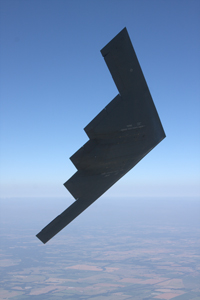 |
A B-2 stealth bomber on a training mission |
Beginning in 1992, the nuclear mission was divided between Air Combat Command and Air Force Space Command. In many ways, it became secondary in competitions for attention, resources, and prestige.
Now, the SAC outlook is coming back—because that’s the way things need to be when dealing with the most powerful weapons on Earth. The creation of Global Strike Command, with a singular focus on the nuclear enterprise, is designed to underline that. “It became clear” that nuclear and conventional missions were “out of balance,” Klotz said. Strike Command is to put them back into balance.
Col. Ferdinand B. Stoss III, commander of the 91st Missile Wing at Minot AFB, N.D., noted that the loss of focus was a change in culture that “took time, and it will take time to build it back.” Part of the problem, he explained, was that over time the space side of the 13S career field that space and missile officers share became more prestigious than the missile side. When missileers finished their initial tours, most of the best and brightest were switching to space operations for their follow-on tours.
Best and Brightest
Priorities have already changed. Stoss reports that space ops will still inherit the majority of graduating missileers because that field requires greater numbers of midcareer officers. But the “best and brightest” missileers are now progressing into both career tracks—and there are more volunteers for career follow-on nuclear assignments than there are spaces available.
Veteran airmen in the nuclear fields— missiles, bombers, munitions, and maintenance—all said they see the new focus most clearly in the new intensity of the exercises and inspections. They are training and being judged more frequently, and more harshly, than at any point in most of their careers.
In some cases, the training must be intensified just to keep pace with the real world. Stoss noted that because of overlapping modernization and upgrade schedules, the operating tempo for Minuteman III operators and maintenance personnel is at an all-time high. While on alert, “you never know when something’s going to come up,” said 2nd Lt. John Farnell, a deputy crew commander in the 740th Missile Squadron. “It’s feast or famine.”
This affects training as well.
“In the mid-to-late [1990s], many alerts were the same,” said Lt. Col. Todd Schollars, who oversees missile procedure training. Alerts have become “incredibly complex,” he said, because several missiles could be undergoing maintenance at the same time. Officials have had to increase the intensity of the training “just to replicate the field.”
In other cases, the training has been intensified to meet the most stressing scenarios. Capt. Tom Meagher, a B-52 aircraft commander with the 69th Bomb Squadron, noted that the focus for one week at the end of March was on strategic attack and dealing with fighter intercepts.
From 2007 through 2009, Minot was on the front lines of the Air Force’s nuclear struggles. The commander of the 5th Bomb Wing was among those fired in 2007 after nuclear cruise missiles were accidentally flown from Minot to Barksdale AFB, La.
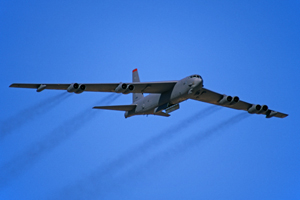 |
A B-52 on a Red Flag sortie over Nevada. Both bomber types are ready to perform nuclear or conventional missions. (Photo by Ted Carlson) |
The commander of Minot’s missile wing was later relieved from command, in October 2009, after a pair of high profile nuclear-related incidents at the base. Just two weeks after that, the 5th Bomb Wing’s replacement commander was removed after units failed several inspections. (The three Minot wing commanders were all removed before their units joined Global Strike Command.)
“Airmen didn’t fail the Air Force when we had these breakdowns,” Maj. Gen. C. Donald Alston, later said. “The Air Force failed our airmen. … We had not given the enterprise the attention that nuclear missions demand.”
Morale was down at Minot after the mistakes and failed inspections last year, said CMSgt. Martin K. Smith, command chief for the 5th Bomb Wing, but the confidence has returned.
When the current bomb wing commander, Col. Douglas A. Cox, was first reassigned from Guam to Minot last October, he acknowledged that he was concerned about what he would find. What he found was “commitment and dedication to get [things done] right,” he said. This January, the fledgling 69th Bomb Squadron passed its initial nuclear surety inspection and the 5th Bomb Wing simultaneously passed a no-notice NSI.
Getting 95 percent of the questions correct will earn someone an “A” on a test at any university, Klotz said, but 95 out of 100 could cause a base to fail an NSI—if the errors are in the wrong places.
Still, “Airmen will do what they are asked to do,” said Smith, and with time and repetition, they “may think this is normal.”
A Way of Life
The goal is to identify potential problems early, before they become major issues, not to “pass” or “fail” a given number of units. Inspections that are impossible to pass serve little purpose—but so do NSIs that are not tough enough.
These inspections are important, but just “one indicator of how a unit is performing,” said Col. Sandra E. Finan, GSC inspector general at Barksdale.
“In our business, perfection is our output,” but this must be achieved by humans who are imperfect, Finan noted. Built-in operational redundancies can mask some problems if inspectors don’t dig deeply enough, so finding the correct level of inspection difficulty is a constant balancing act. Global Strike Command today takes larger sample sizes and brings more inspectors, typically about 100 for an NSI. This allows for a deeper drilling down into procedures.
Finan said the no-notice NSIs are a valuable way to evaluate day-to-day performance, and a unit can expect to be inspected about twice per year.
For the younger troops, today’s intensity is just a way of life. First Lt. Jannel Emery, an instructor and evaluator in the 91st Operations Support Squadron that tests missileers, put it succinctly: “This is our job.” Airmen have “adapted to intense ops,” she said.
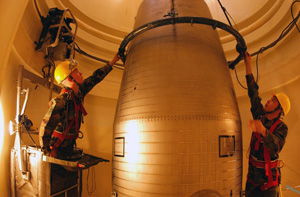 |
Missile maintenance technicians work on a Minuteman III ICBM in its launch silo during a nuclear surety inspection at Malmstrom AFB, Mont. |
For bombers, conventional missions were the priority for many years, but it is no longer appropriate to even say the nuclear-capable bomb crews have divided attention, said Cox. Today’s focus is on nuclear responsibilities “first and foremost” with conventional operations an additional duty. With the nuclear mission serving as the “foundation” for everything the wing does, Cox said, other responsibilities such as the Pacific presence mission can be methodically worked in.
Bomber crews go beyond being “dual-hatted” by offering both nuclear and conventional capabilities. “We’re dual-wardrobed,” said Capt. Matthew Guasco, a pilot with the 23rd Bomb Squadron. Crews must “keep both ends of the spear sharp.”
Things must be carefully balanced, but Klotz notes USAF has performed this balancing act many times before. SAC bombers performed conventional missions as far back as the Korean War, and B-2s and B-52s today deploy to support US Pacific Command’s continuous forward presence mission on Guam.
Activating the 69th Bomb Squadron gives Minot and Barksdale two operational B-52 squadrons each, so that one squadron can be assigned to the Global Deterrence Force rotation. That job is 100 percent nuclear for a full year.
The new squadron is bringing 800 airmen to Minot—13 percent of the base’s population—but it will take time to build to full capability. Many of the aircrew members and crew chiefs are coming in from other weapons systems, and need to ramp up their skills with the B-52. The shortage of midcareer airmen with nuclear skills is a problem here as well. Lt. Col. Patrick Ballard, deputy commander of the 5th Maintenance Group, said sortie rates should stabilize by the fall, but because of the spin-up times for airmen new to B-52s, life may not fully “normalize” until the spring of 2011.
Infrastructure improvements are progressing to absorb Minot’s new personnel. Large numbers of new dorms and other base housing are under construction. The new bomb squadron needs additional hangars and maintenance facilities, and there are plans for a brand-new control tower and air traffic control complex.
Klotz said the other nuclear bases are also benefiting from infrastructure improvements. Barksdale is adding 1,100 airmen through various nuclear personnel additions and the stand-up of Global Strike Command. These airmen should pose less of an integration strain than at Minot, however, because Barksdale is surrounded by the large communities of Shreveport and Bossier City.
The base does, however, need new buildings to replace some obsolete structures, along with road and weapons storage area (WSA) upgrades.
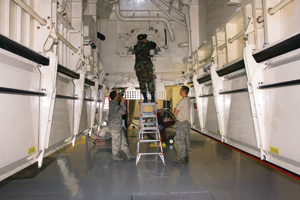 |
SSgt. Dustin Martin (l), SrA. Monicha Pugh (on ladder), and A1C Cody Mc- Connell perform maintenance on a B-2 bomb bay simulator at Whiteman AFB, Mo. |
The Air Force has decided to recertify Barksdale’s WSA, which was closed to nuclear weapons years ago, so that B-52 crews have easier access to strategic weapons for training and exercises. Klotz told Congress that it will take about $150 million to reopen the WSA, but the Air Force was going to wait until the Nuclear Posture Review was completed before moving forward.
The weapons storage areas are of particular interest, because the Minot incident began in the WSA. In the “mid-1990s,” Thomas said, 10 domestic weapons storage areas were operated by three commands. Today, the remaining five “CONUS WSAs” belong to the Nuclear Weapons Center—not the local wing. Their profile has also been raised. “Previously, we had a young captain … responsible for the inner workings inside of the weapons storage area,” Thomas testified. “We moved that to a lieutenant colonel’s position.”
In addition to the construction at the base, Minot airmen have noticed a marked increase in high-level visitors. In the past, “I think we were a little forgotten about,” said Capt. Lauren Eiffes, a B-52 standards and evaluation officer. That is certainly not the case anymore, she said, citing visits from Defense Secretary Robert M. Gates and Gen. Norton A. Schwartz, USAF Chief of Staff.
Indeed, Gates cited the erosion in nuclear standards as the reason he forced then-Air Force Secretary Michael W. Wynne and Gen. T. Michael Moseley, Schwartz’s predecessor, to resign in June 2008. Renewed attention brings with it more personnel, higher standards, and additional funding.
The nuclear enterprise needs all of this, because much of its resources are ancient, beginning with 40-year-old Minuteman IIIs. “Much of the infrastructure—for example, missile silos, launch control centers, missile alert facilities, underground cables—were fielded even earlier, with previous generations of the Minuteman,” Klotz told lawmakers in March.
The last B-52, meanwhile, “left the factory in 1962.” There are only 77 B-52s and 20 B-2s, and no new bomber has been produced since 1997. Global Strike Command will advocate for a next generation long-range strike aircraft, one that will in all likelihood be nuclear-capable.
Another aircraft of concern is the UH-1 used to help defend the nation’s missile fields. These Hueys date to 1970, and have severe range, size, and performance limitations. Lt. Col. Jay Tewksbury, commander of Minot’s 54th Helicopter Squadron, notes that the Hueys are highly reliable and easy to maintain, but their performance limitations are too great to look past. For example, they lack a deicing capability, which can be a major problem at the Northern Tier missile bases.
The helicopter units work with specially trained, 17-man tactical response forces trained for counterterrorism operations. Why 17 men? “Too many people get in the way,” said MSgt. Duke McDuffie, superintendent of the 791st Missile Security Forces Squadron’s TRF unit. The team—ready to assault a missile launch facility (silo) in “any configuration”—includes a command and control airman, an eight-man assault team, a four-man heavy weapons team, two snipers, and two spotters.
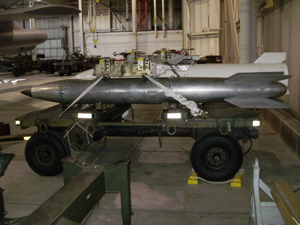 |
A mockup of a B61 bomb used for nuclear weapons load training at Minot AFB, N.D. AFGSC’s B-52s can deliver a wide variety of cruise missiles and gravity bombs. |
All are security forces veterans serving three-year controlled tours, drawn from volunteers among the security forces airmen at the nuclear weapons bases.
Team member SSgt. Augustin Torres said the team “specializes in close quarter combat,” for example within an occupied missile silo. But despite the popular reputations of assault teams like this, Torres added, the TRF’s job is “not to kill everybody; … [it] is to save lives.”
The TRF concept originated in 2002 to meet the greater security requirements since 9/11, but Tewksbury notes that it takes three Hueys to transport a TRF. Minot only has eight UH-1s, with six or seven fully mission-capable at most times.
After years of delay, the Air Force included funding in the 2011 budget request to begin a helicopter replacement program, with a target in-service date of 2015. Tewksbury said security forces would benefit from helicopters with greater speed, all-weather capability, and the ability to transport a TRF in two aircraft instead of three.
No “Showstoppers”
Nuclear test and support equipment is a particular concern. For years, Thomas explained, there were questions about who was responsible for nuclear sustainment. At one point the Air Force tried to launch a Mk 21 fuze refurbishment program, but it had no general officer involvement, and ultimately went nowhere. The Air Force was forced to start over.
The Mk 12 and Mk 21 fuzes that arm ICBM warheads both need refurbishment, and the NWC considers these fuzes a top sustainment concern. Col. James D. Fisher, commander of the 526th ICBM Systems Group, notes that the Mk 21 fuze was never designed to be refurbished—part of the reason the service is interested in developing with the Navy a joint/common fuze that could be used for both the Minuteman III and SLBMs.
Nuclear gravity bombs are also on the agenda. The Air Force supports a life extension program for the B61 bomb carried by USAF’s heavy bombers and many dual-role fighters. The goal is to improve the safety, security, and reliability of a weapon that still carries vacuum tubes.
As the Nuclear Weapons Center works “on a comprehensive life extension of the versatile B61, [it is] also studying the need for weapons to meet future delivery platform requirements,” Thomas said.
Officials have already identified the need for a next generation cruise missile. USAF began developing the requirements for the new weapon this spring, and is expected to soon begin a formal analysis of alternatives.
The service is continuing to decommission its stealthy Advanced Cruise Missiles and cut its inventory of Air Launched Cruise Missiles, but dozens of ALCMs will continue to provide standoff punch for the B-52 fleet. The plan, says Col. Richard M. Stuckey, commander of the 498th Nuclear Systems Wing at Kirtland, is to sustain the remaining ALCMs until 2020, with a “guarded option” of preserving them to 2030.
The Air Force has a “good handle” on which components will not last the life of the weapon, he said. The key is long-term planning.
ICBMs are in a similar situation. The 2007 defense authorization act directed USAF to sustain the Minuteman III through 2030. The service recently put together its first ICBM roadmap in a decade to help meet this requirement.
The roadmap calls for “smaller but steady investments … to sustain the weapon system until a replacement system is fielded. Block upgrades in flight, ground, and support equipment subsystems are the best approach.”
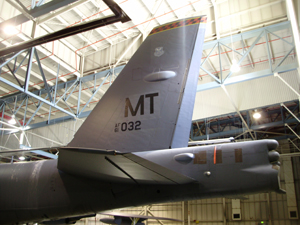 |
Minot is adding operational B-52s to fill out a new bomb squadron. This B-52 in a base hangar is being used for weapons load training. Both Minot and Barksdale AFB, La., home of Strike Command, will have two bomb squadrons and will require infrastructure improvements. |
This echoes the approach the Air Force has used on the Minuteman in the past. The service is now wrapping up $7 billion worth of multiyear propulsion and guidance replacement programs. Klotz last year said these have modernized “practically every inch” of the missile. Some Minutemen are even getting replacement re-entry vehicles from decommissioned Peacekeeper missiles.
The roadmap notes that 2030 is still a long way off, however, and “additional work” will be needed to identify what parts will need refurbishment to meet the new life requirement.
Fisher said he sees no “showstoppers” on the ICBM sustainment horizon, but the Air Force will “have to refresh some items of concern once again.”
It will take time to rebuild the nuclear systems, equipment, expertise, and culture that declined since SAC’s dissolution in 1992. Officials have not necessarily become accustomed to the new requirements, but all seem to feel they are now operating at a higher level of proficiency.
The no-notice inspections clearly keep airmen on their toes. Technically, they are “very little” notice inspections because teams might get shot if they showed up at nuclear weapons facilities completely unannounced. Still, Kirtland’s Stuckey noted, the last three inspections he was privy to offered five hours’ notice, then four hours, then 24 hours. This serves to keep airmen at a “higher and consistent level of readiness,” he said.
Last November, when Thomas spoke to Air Force Magazine at Kirtland, there were about a hundred inspectors performing a nuclear surety inspection at the base. Despite this and the other difficulties that inevitably lie ahead, Thomas said, “I smile a lot more than I did when I got here.”
| Setting Up for Nuclear Success
During the Cold War, Strategic Air Command had responsibility for nearly all things nuclear. In recent years, however, the nuclear mission has been split between Air Combat Command for bombers, Air Force Space Command for ICBMs, and Air Force Materiel Command for sustainment. Nuclear issues were often not the top priority. To restore the nuclear enterprise to its rightful place at the top of the Air Force’s domestic priority list, USAF made many changes that have just recently been realized. Air Force Global Strike Command was created to oversee nuclear operations. It is the first all-new major command since Space Command was established in 1982. Strike Command encompasses 23,000 airmen at five bases, and just assumed control of the B-2 and B-52 bomber fleets in February. An additional B-52 squadron, the 69th Bomb Squadron, was activated at Minot so that both BUFF bases would have two operational squadrons and the ability to support the new Global Deterrence Force. GDF calls for one B-52 unit to spend a year at a time dedicated to nuclear missions. The Air Force Nuclear Weapons Center at Kirtland AFB, N.M., now has Air Force-wide responsibility for sustainment. The NWC was created in 2006, but it is being expanded from less than 10 personnel to more than 200. Brig. Gen. Everett H. Thomas is the first general officer commander of the weapons center. After several years with no senior officer on the Air Staff having an exclusively nuclear focus, USAF established the A10 assistant chief of staff position. Maj. Gen. C. Donald Alston is the first A10. In recognition of the fact that (short of the Chief of Staff) there was no four-star general directly responsible for nuclear sustainment, AFMC’s Gen. Donald J. Hoffman was placed in charge of oversight. Finally, the Air Force established a new program executive office position for strategic systems, collocated with the NWC at Kirtland. Brig. Gen. John F. Thompson became the first PEO for strategic systems in March. |